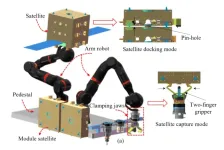(Press-News.org) Research Highlights:
Cardiovascular deaths from extreme heat in the United States are projected to increase by 162% by the middle of the century, based on a hypothetical scenario where currently proposed U.S. policies to reduce greenhouse gas emissions have been successfully implemented.
A more dire scenario forecasts cardiovascular deaths from extreme heat could increase by 233% in the next 13-47 years if there are only minimal efforts to reduce emissions.
The percentage increase in deaths will be greater among elderly people and non-Hispanic Black adults in either scenario.
Embargoed until 4 a.m. CT/5 a.m. ET Monday, Oct. 30, 2023
DALLAS, Oct. 30, 2023 — Cardiovascular deaths from extreme heat in the U.S. may more than double by the middle of the century. Without reductions in greenhouse gas emissions, that number could even triple, according to new research published today in the American Heart Association’s flagship journal Circulation.
“Climate change and its many manifestations will play an increasingly important role on the health of communities around the world in the coming decades, “ said lead study author Sameed Khatana, M.D., M.P.H., assistant professor of medicine at the University of Pennsylvania and a staff cardiologist at the Philadelphia Veterans Affairs Medical Center, both in Philadelphia. “Climate change is also a health equity issue as it will impact certain individuals and populations to a disproportionate degree and may exacerbate preexisting health disparities in the U.S.”
How much and how quickly greenhouse gas emissions increase in the next decades will determine the health impacts of extreme heat. More aggressive policies to reduce greenhouse gas emissions have the potential to reduce the number of people who may experience the adverse health effects of extreme heat, according to Khatana.
Previously, the authors examined county-by-county data in the continental U.S. to demonstrate a link between a greater number of extreme heat days and an increase in cardiovascular deaths between 2008-2017. This data served as a benchmark for the analysis in this new study. Researchers used models for future greenhouse gas emissions and future socioeconomic and demographic makeup of the U.S. population to estimate the possible impact of extreme heat on cardiovascular deaths in the middle years of the current century (2036-2065). They estimated the excess number of cardiovascular deaths associated with extreme heat by comparing the predicted number of deaths for each county if no extreme heat occurred vs. if the projected number of heat days occurred.
The analysis found:
Between 2008 and 2019, extreme heat was associated with 1,651 excess cardiovascular deaths per year.
Even if currently proposed reductions in greenhouse gas emissions are fully implemented, excess cardiovascular deaths due to extreme heat are projected to be 162% higher in the middle of this century compared to the 2008-2019 baseline.
However, if those greenhouse gas emissions reduction policies are not implemented, excess cardiovascular deaths due to extreme heat are projected to increase 233% in the coming decades.
Depending on how aggressively policies to reduce greenhouse gas emissions are implemented, adults aged 65 and older are projected to have a 2.9 to 3.5 times greater increase in cardiovascular death due to extreme heat in comparison to adults ages 20-64.
Non-Hispanic Black adults are projected to have a 3.8 to 4.6 times greater increase in cardiovascular death due to extreme heat compared with non-Hispanic white adults, depending on the degree to which greenhouse policies are implemented.
Projected increases in deaths due to extreme heat were not significantly different among adults in other racial or ethnic groups, or between men and women.
“The magnitude of the percent increase was surprising. This increase accounts for not only the known association between cardiovascular deaths and extreme heat, but it is also impacted by the population getting older and the proportionate increases in the number of people from other races and/or ethnicities in the U.S.,” Khatana said.
Both medical and environmental factors may influence the greater impact of extreme heat for people in these population groups, he said. Disparities in neighborhood and environmental factors are crucial factors to also consider.
“Previous studies have suggested Black residents may have less access to air conditioning; less tree cover; and a higher degree of the ‘urban heat island effect’ — built-up areas having a greater increase in temperature than surrounding less-developed areas,” Khatana said. “Living conditions may also have a role in terms of social isolation, which is experienced by some older adults and has previously been linked with a higher probability of death from extreme heat.”
The findings are unfortunately, not surprising, according to American Heart Association volunteer Robert Brook, M.D., FAHA, who has co-authored several Association scientific statements on air pollution and was not involved in this study.
“Even under the more optimistic moderate scenario of this study, greenhouse gas emissions will increase for some time before tapering down,” said Brook, professor of medicine and executive director of cardiovascular prevention at Wayne State University School of Medicine in Detroit. “Moreover, most of the pollutants persist in the atmosphere for numerous years, and as such, the long-term trend is for significant increases in the frequency of extreme heat events despite near-term actions.
“In conjunction with the growth of more susceptible and vulnerable populations — aging adults and people relocating to warmer locations — heat-related cardiovascular disease deaths are expected to increase over the coming decades. Nevertheless, the study shows that the magnitude of adverse cardiovascular disease effects may be somewhat mitigated by taking earlier action to reduce greenhouse gas emissions that drive climate change.”
While the projections may appear alarming, they are likely conservative, Brook noted.
“The projections of this study focus on cardiovascular disease deaths, and, therefore, they represent conservative estimations of the adverse effects on cardiovascular health due to extreme heat,” he said. “Nonfatal heart attacks, strokes and heart failure hospitalizations outnumber fatal events and are also highly likely to be linked with extreme heat days. The full extent of the public health threat, even just due to cardiovascular death, is likely much greater than presented in this study. “
The projections raise the question of whether infrastructure interventions, such as increasing tree cover in neighborhoods, may lead to improvements in the number of people affected by extreme heat in the U.S. Some research results from Europe suggest that this may be the case, however, studies in the U.S. are lacking.
Brook also noted the role of pollution with excessive heat: “Fine particulate matter air pollution (PM2.5) causes more than 6 million deaths per year. This study adds to the evidence that the full extent of the harmful effects posed by air pollutants extends beyond PM2.5. By substantially increasing extreme heat days, greenhouse air pollutants pose yet further threats to our well-being.”
Study details and background:
The researchers compared excess cardiovascular deaths due to extreme heat under two scenarios used by the Intergovernmental Panel on Climate Change, an international body that assesses the science related to climate change caused by human activities. The scenarios were:
successful implementation of currently proposed, moderate emission reduction policies so there are lower increases in greenhouse gas emissions; or
no significant emission reduction efforts and greenhouse gas emissions continue to increase at the same rate they have over the last two decades.
As a baseline, the researchers used county-by-county records from 2008-2019 for deaths during summer months with a primary cause of any cardiovascular condition (including heart attack and stroke), and related data such as the age, sex, race and ethnicity of each person who died and the number of extreme heat days (days with a maximum heat index of 90oF or higher) during the month of the death. The heat index considers both heat and humidity because that reflects how the human body experiences high temperatures, with high humidity interfering with the body’s ability to release heat by sweating.
These results, from data in the continental U.S., may not apply to people living in other regions of the U.S. or the world. The study is also limited by employing two plausible projections of extreme heat and population change, and it is possible that the actual changes in the U.S. may be different.
Co-authors and their disclosures are listed in the manuscript. The study was funded by the American Heart Association and the National Heart, Lung, and Blood Institute, a division of the National Institutes of Health.
Studies published in the American Heart Association’s scientific journals are peer-reviewed. The statements and conclusions in each manuscript are solely those of the study authors and do not necessarily reflect the Association’s policy or position. The Association makes no representation or guarantee as to their accuracy or reliability. The Association receives funding primarily from individuals; foundations and corporations (including pharmaceutical, device manufacturers and other companies) also make donations and fund specific Association programs and events. The Association has strict policies to prevent these relationships from influencing the science content. Revenues from pharmaceutical and biotech companies, device manufacturers and health insurance providers and the Association’s overall financial information are available here.
Additional Resources:
Multimedia is available on the right column of release link https://newsroom.heart.org/news/heat-related-cardiovascular-deaths-in-the-u-s-may-more-than-double-within-decades?preview=880e45b4ec096375a8c2aff458d27b76
After Oct. 30, view the manuscript online.
AHA news release: Risk of fatal heart attack may double in heat wave & high fine particulate pollution days (July 2023)
AHA news release: Particulate air pollution a growing risk for premature CVD death and disability worldwide (Aug. 2023)
AHA news release: Extremely hot and cold days linked to cardiovascular deaths (Dec. 2022)
AHA news release: Extreme, high temperatures may double or triple heart-related deaths (March 2020)
Follow AHA/ASA news on X (formerly known as Twitter) @HeartNews
Follow news from AHA’s flagship journal Circulation @CircAHA
About the American Heart Association
The American Heart Association is a relentless force for a world of longer, healthier lives. We are dedicated to ensuring equitable health in all communities. Through collaboration with numerous organizations, and powered by millions of volunteers, we fund innovative research, advocate for the public’s health and share lifesaving resources. The Dallas-based organization has been a leading source of health information for nearly a century. Connect with us on heart.org, Facebook, X or by calling 1-800-AHA-USA1.
###
END
Heat-related cardiovascular deaths in the U.S. may more than double within decades
In nationwide projections, elderly and Black adults are most at risk for cardiovascular death due to extreme heat, finds a new study in journal, Circulation
2023-10-30
ELSE PRESS RELEASES FROM THIS DATE:
Penn research projects increase in US cardiovascular deaths due to extreme heat
2023-10-30
PHILADELPHIA— The number of heat related cardiovascular deaths in the United States will increase over the next four decades, according to a new analysis from the Perelman School of Medicine at the University of Pennsylvania. Extreme heat can impact heart health in many ways, including increased heart rate, changes in blood pressure, and increased inflammation. Left untreated, these issues can be deadly. The findings, published today in Circulation, also indicate that older adults and Black adults will experience greater increases in excess cardiovascular deaths due to extreme heat.
“As global temperatures rise, analyzing how demographic and environmental trends ...
Child Development Perspectives Journal Q&A: analyzing the stereotypes of adolescence
2023-10-30
In Western cultures, adolescence is often viewed as a time of rebellion and irresponsibility. A new article published in the journal Child Development Perspectives synthesized recent research on stereotypes of adolescence using an interdisciplinary approach which integrates developmental psychology, cultural psychology, and neuroscience.
The findings highlight the importance of avoiding the “one-size fits-all” assumptions about teen stereotypes across different cultures. In particular, the research ...
Trauma-informed training workshops prompt meaningful individual and organizational changes, according to outcomes surveys
2023-10-30
A McLean Hospital study of 598 people across various industries who underwent a two-day training workshop where they learned about trauma-informed care and how to deploy these skills within their organizations, found participants reported significant gains in knowledge of trauma and made improvements to organizational policies, according to a comparison of survey data collected before and after the trainings.
Among those trained, who included nurses, CEOs, academics and corrections officers, post-survey scores increased ...
Study of 1,000 selfies helps explain how we use them to communicate
2023-10-30
People have used self-portraits to communicate information about themselves for centuries — and digital cameras make it easier to share a self-portrait than ever before. But even though selfies are now almost ubiquitous, we don’t understand how people use them to communicate. So scientists from the University of Bamberg set out to investigate the semantics of selfies.
“Although the term ‘selfies’ is now celebrating its 21st birthday, and although selfies are known in art history for nearly 200 years in photography and more than 500 years in paintings, we still lack a clear classification of the different types of selfies,” ...
Powder engineering adds AI to the mix
2023-10-30
Imagine a world without powders. It may sound exaggerated, but our daily lives are intricately connected to powders in various ways from foods, pharmaceuticals, cosmetics to batteries, ceramics, etc. In all these industries, powder mixing is an important unit operation where different types of powders are mixed to achieve uniformity. However, it can be difficult to predict what conditions are optimal to achieve the desired uniformity as the process often relies on trial and error as well as engineers’ expertise.
Numerical ...
Risk of admission and death from COVID-19 low overall, but oldest adults remain vulnerable
2023-10-30
About 80% of residents in the Lower Mainland, British Columbia, had been infected with SARS-CoV-2 by July 2023 and were at low risk for severe outcomes, but almost half of the oldest adults remained uninfected and were at highest risk of hospitalization and death due to COVID-19, according to a new study published in CMAJ (Canadian Medical Association Journal) https://www.cmaj.ca/lookup/doi/10.1503/cmaj.230721.
The findings underscore the need to continue prioritizing older adults for COVID-19 vaccination.
"First-ever SARS-CoV-2 infections among older adults may still contribute substantial COVID-19 burden, reinforcing ...
High engagement, high return: The secret to student success
2023-10-29
High engagement, high return. That’s the advice from education experts at the University of South Australia for teachers looking to improve student outcomes.
In a new study conducted in partnership with Flinders University and Melbourne Graduate School of Education, researchers found that less than a third of teachers are engaging students in complex learning, limiting student opportunities for building critical thinking and problem solving.
Filming and assessing* the content of classrooms ...
Robot space maintenance based on human arm dynamics
2023-10-28
On-orbit assembly has become a crucial aspect of space operations, where the manipulator frequently and directly interacts with objects in a complex assembly process. The traditional manipulator control has limitations in adapting to diverse assembly tasks and is vulnerable to vibration, leading to assembly failure. To address this issue, Researchers at Beijing Institute of Technology propose a human-like variable admittance control method based on the variable damping characteristics of the human arm. This method can effectively increase the safety, robustness, ...
Increasing risk of invasive species colonization on marine debris
2023-10-28
A groundbreaking scientific study conducted along the Southeast coast of India has unearthed a pressing environmental concern -the increasing risk of invasive species colonization on marine debris. The research, published recently in Marine Pollution Bulletin, delves into the critical interplay between plastic pollution and the introduction of non-indigenous organisms into Indian waters.
In recent years, the surge in anthropogenic litter in the ocean has provided an extensive array of substrates for marine ...
How do animals know it’s lunchtime?
2023-10-28
Tokyo, Japan – Researchers from Tokyo Metropolitan University have used fruit flies to study how daily eating patterns are regulated. They found that the quasimodo (qsm) gene helped sync feeding to light/dark cycles, but not in constant darkness: instead, the genes clock (clk) and cycle (cyc) keep eating/fasting cycles, while other “clocks” in nerve cells help sync it to days. Deciphering the molecular mechanism behind eating cycles helps us understand animal behavior, including our own.
Many members of the animal kingdom eat at roughly the same times each day. This is born out of the need to adapt to aspects of the environment, including ...
LAST 30 PRESS RELEASES:
Johns Hopkins-led team creates first map of nerve circuitry in bone, identifies key signals for bone repair
UC Irvine astronomers spot largest known stream of super-heated gas in the universe
Research shows how immune system reacts to pig kidney transplants in living patients
Dark stars could help solve three pressing puzzles of the high-redshift universe
Manganese gets its moment as a potential fuel cell catalyst
“Gifted word learner” dogs can pick up new words by overhearing their owners’ talk
More data, more sharing can help avoid misinterpreting “smoking gun” signals in topological physics
An illegal fentanyl supply shock may have contributed to a dramatic decline in deaths
Some dogs can learn new words by eavesdropping on their owners
Scientists trace facial gestures back to their source. before a smile appears, the brain has already decided
Is “Smoking Gun” evidence enough to prove scientific discovery?
Scientists find microbes enhance the benefits of trees by removing greenhouse gases
KAIST-Yonsei team identifies origin cells for malignant brain tumor common in young adults
Team discovers unexpected oscillation states in magnetic vortices
How the brain creates facial expressions
Researchers observe gas outflow driven by a jet from an active galactic nucleus
Pitt student finds familiar structure just 2 billion years after the Big Bang
Evidence of cross-regional marine plastic pollution in green sea turtles
Patients with clonal hematopoiesis have increased heart disease risk following cancer treatment
Stem cell therapy for stroke shows how cells find their way in the brain
Environment: Up to 4,700 tonnes of litter flows down the Rhine each year
Maternal vaccine receipt and infant hospital and emergency visits for influenza and pertussis
Interim safety of RSVpreF vaccination during pregnancy
Stem cell engineering breakthrough paves way for next-generation living drugs
California grants $7.4 million to advance gene-edited stem cell therapy for Friedreich’s ataxia
Victoria’s Secret grant backs cutting-edge ovarian cancer research
Research paves the way for safer colonoscopy bowel prep for people with compromised gut health
JMIR Publications and Sweden's National Library announce renewal and expansion of flat-fee unlimited open access partnership for 2026
A new 3D-printed solar cell that’s transparent and color-tunable
IV iron is the cost-effective treatment for women with iron deficiency anemia and heavy menstrual bleeding
[Press-News.org] Heat-related cardiovascular deaths in the U.S. may more than double within decadesIn nationwide projections, elderly and Black adults are most at risk for cardiovascular death due to extreme heat, finds a new study in journal, Circulation





